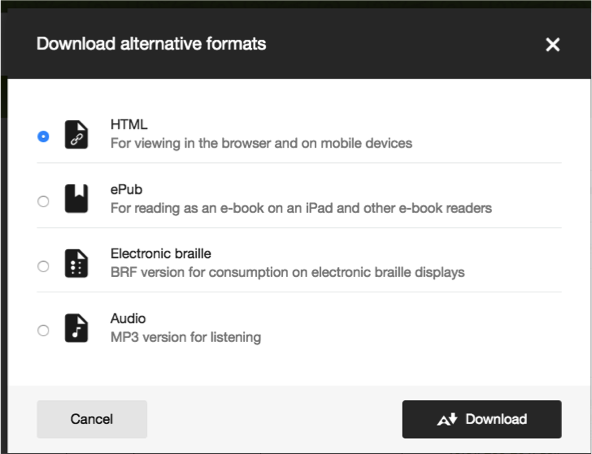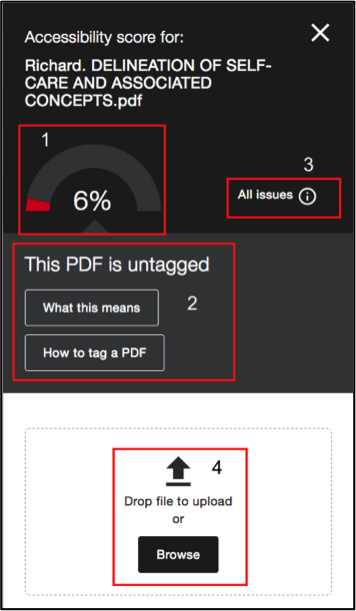Ally Guide for Faculty
What is ALLY?
ALLY is an add-on feature of Blackboard to assist faculty in making our courses accessible to students with disabilities and learning differences. ALLY uses a set of algorithms to analyze many types of content you use in your courses and assesses its accessibility according to national standards.
ALLY does not change your original files. It provides resources for you and your students.
- In instructor view, ALLY shows a small meter indicating the degree of access provided by the document. When you click on the meter, you will receive tips about how to make your document more accessible.
- In student view, the accessibility meter is not shown. Instead, a down arrow appears next to each document. When clicked, a list displays 4 or more alternative formats of your original. Ally converts your files into screen readable pdfs and htmls. It creates a digital braille file. Ally also produces a digital audio file (mp3) of the document being read aloud by a computer-generated voice.
Why is ALLY Important?
Linfield is committed to making our instructional environments welcoming and academically rigorous for all students. Poorly designed physical spaces can present obstacles for some learners. Likewise poorly designed digital spaces can present obstacles for some learners. We have a responsibility to provide equal opportunities to our students who have physical, sensory and cognitive differences. By providing alternative ways of accessing our teaching we improve the learning experience of all students.
Meters
Color coded meter icons appear next to files and images that have been uploaded to a blackboard page. The meter gives you a quick view of how accessible your document is. Green indicates that the document is mostly accessible. Orange indicates that accessibility issues exist. Red indicates poor accessibility.

Help Pane
When you click on a meter, a window will appear on the right side of your screen. It provides:
- An accessibility score
- The issue that has the biggest impact on the accessibility of the document, with information on how to correct it.
- A link to a description of all issues in the document.
- An upload option to replace the original file.
This video demonstrates the use of the color coded meter icons. Color coded meter icons appear next to files and images that have been uploaded to a blackboard page. The meter gives you a quick view of how accessible your document is. Green indicates that the document is mostly accessible. Orange indicates that accessibility issues exist. Red indicates poor accessibility.
To enlarge this video, click on the double arrows in the bottom, right of the video window.
How to Upload a Tagged PDF
This video demonstrates how to first convert your word document to a tagged pdf and then how to upload it to your Blackboard page. *Note pdfs can only be converted with tags on Microsoft Office 16 and above. As a Linfield employee, you are entitled to a current version of Microsoft Office. Contact ITS if you have questions about how to get a copy.
To enlarge this video, click on the double arrows in the bottom, right of the video window.
How to Add Accessible Headings in Microsoft Word
This video demonstrates how to use headings styles in Word, instead of bold font, to organize your text into sections. Headings allow for screen readers to notify the listener when a new section starts.
To enlarge this video, click on the double arrows in the bottom, right of the video window.
How to Add Alternate Text to Images in Microsoft Word and Blackboard
This video demonstrates how to add alternate text to images on Microsoft word and Blackboard. Alternate text on images helps screen readers to decipher what the image is about for those who cannot see it.
To enlarge this video, click on the double arrows in the bottom, right of the video window.
To enlarge this video, click on the double arrows in the bottom, right of the video window.
How to Create Descriptive Hyperlinks
This video shows how to hyperlink descriptive text. In most cases linking words that describe the hyperlink is preferable to displaying the whole URL, or linking generic words like "click here."
To enlarge this video, click on the double arrows in the bottom, right of the video window.
How to Request Captions for videos
Ally doesn't deal with video accessibility yet. If you use Kaltura to make and store your videos, you can request captions. This video shows how to request captions and then edit them for your media.
To enlarge this video, click on the double arrows in the bottom, right of the video window.
How Students see Alternate Formats
 ALLY automatically creates alternative formats from your original. Students can click a down arrow next to your original file and select Alternative formats. The student is given the list of alternative format: HTML, ePub, Electronic braille and Audio. These formats include accessibility corrections when available.
ALLY automatically creates alternative formats from your original. Students can click a down arrow next to your original file and select Alternative formats. The student is given the list of alternative format: HTML, ePub, Electronic braille and Audio. These formats include accessibility corrections when available.

